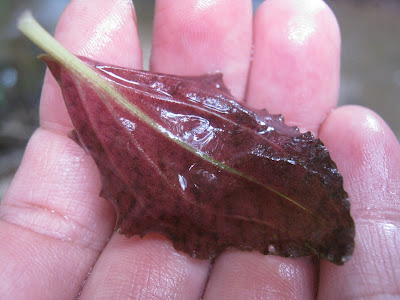During this trip I also visited C. affinis 'West Pahang' again after a simple lunch of fried bee hoon beside a cat taking a nap.
The habitat is a small river with fast flowing water, below is a video clip of it.
The water level is much lower this time, a large part of the island which was below water previously was now above above the water level. The emersed leaves (could be submersed leaves previous but were now left exposed to the air after the water level fell) photographs are attached below, the leaves were bullate and greenish in colour.
There were portion of the island (i.e. at the edges) which should be more often submersed. The leaves of such area showed a darker colour at the under side.
The bed of the river was sandy and the pH was neutral (i.e. about 7.0) as expected for C. affinis habitats.
As per the previous trip, many flowering specimens could be found here.
A freshwater clam was found too.
Saturday, January 29, 2011
Friday, January 28, 2011
C. nurii 'West Pahang'
I visited the habitat of C. nurii in West Pahang again recently. This is the variety of C. nurii with miniature spathe as can be seen later. Below is a video clip of the habitat (a small river with fast flower water) for your reference.
Both emersed and submersed specimens could be found at this location.
Some collector probably named the specimens found here as C. nurii 'Central Pahang'. My explorer friend named the C. nurii found here as "luminous green" due to the luminous green marking which could be seen on the upper side of the leaves. Some of the leaves veins were rather pronounced too but not enough to be termed as "rosanervig". The edge of the leaves was wavy too (common for C. nurii) and the under side could be reddish in colour.
We found the spathe of this specimen again this time round and took some close up photograph of it. The flower only vaguely resemble the typical spathe of a C. nurii (i.e. bright red, heart shape with protuberances on the limb) in my opinion. The limb of this variety can be considered as being more crinkled than having protuberances.The below photograph will clearly show why I said that they had miniature spathe. The tube of the spathe was extremely short for this variety of C. nurii.
The photographs of the interior of the kettle as usual.The bed of the river was sandy with water with neutral pH.
So would these specimens fall under the category of C. nurii in your opinion after you reviewed the above photographs?
Thursday, January 27, 2011
C. cf. affinis 'Pink Rosa Pahang'
I managed to visit the state of affinis kingdom, i.e. Pahang state with my explorer friend and he brought me to a few locations where affinis could be found. Below is one of such location with specimens which my friend termed as "Pink Rosa" (rosa = rosanervig) in his blog.
The habitat is a small river with flowing water, see below for a short video clip of the habitat.
Both emersed and submersed specimens could be found. The specimens found in this location can be considered as small size as compared to other C. affinis found.
The close up photographs below showed some specimens with pinkish veins on the leaves, which is why my friend termed them as "Pink Rosa". The upper side of the leaves was either greenish or brownish in colour while the under side was reddish.The emersed form had bullate green leaves.
Below is a close up of the submersed leaves.
The substrate was made up of fine sand mixed with plant debris and the pH of the water was about 7.0.
Although no spathe could be found, I guess that these specimens should likely be C. affinis based on the appearance of the leaves and the location of the habitat.
Saturday, January 22, 2011
C. sp. 'Pahang 2' finally flowered after 1.5 years
Year 2010 was quite a flowerless year for me. However, C. sp. 'Pahang 2' finally flowered this month (i.e. Jan 2011) after more than 1.5 years in cultivation. I believed this could be what some other people termed as "C. nurii with cordate leaves" on the Internet. Below are the photographs of the spathe and interior of the kettle for your reference.
The long limbs actually reminded me more of the C. sp. from Riau Islands (i.e. Bintan, Lingga, Singkep, etc) instead of C. nurii. However, some people felt that those species from Riau Islands could also belong to the C. nurii group anyway.The tube is slightly twisted as noted when we first found the spathe in the forest.
The throat is dark reddish in colour.
The limb is reddish with irregular outgrows / protuberances.
The flab (valve) of the kettle is pale yellowish in colour.
Another view of the dark reddish collar.
The top of the spadix (appendix) is purplish in colour.
The style is rather irregular and long.
This is the close up of the spadix.
And finally another close up shot of the yellowish flab (valve). After your review of the above, is this C. nurii?
Subscribe to:
Comments (Atom)




























































